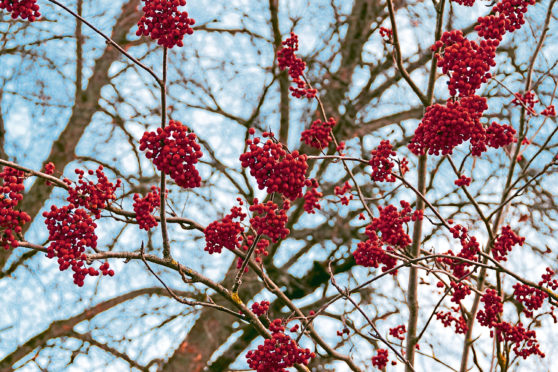Keith Broomfield looks at one of our defining species, the rowan.
A stumble and then a small slip as I made my way down this steep gully in the Ochils.
I hadn’t chosen the easiest route for my descent because on either side of the narrow cleft the ground was broader and more benign, which would have offered a better option.
No matter, for I could see the gully opening out not too far below.
Besides, there was a positive, given that this fissure was out of reach of grazing sheep, making the plant life here more diverse, including a couple of rowans bursting with scarlet berries.
Rowans are the very epitome of Scotland, having a stoic determination that enables them to find hold on the poorest and shallowest of soils, or in rock crevices.
They can survive extreme icy blasts of winter weather for weeks on end, and stand like lone sentinels in our uplands, their branches sculpted by the wind.
Ingrained in our folklore, rowans throw up the most incredible creamy-white blooms in spring that are a magnet for pollinating hill insects, signalling hope and vitality.
Then, in autumn, they hang heavy with glistening red berries, providing sustenance for birds and other creatures.
The leaves also develop a stunning reddish hue in autumn. In Gaelic, the rowan is rather appropriately known as rudha-an – “the red one’”.
Also called the mountain ash, the rowan is strong in spirit and character and supports so much other life yet has a delicate beauty that is a sight to behold.
Celtic Druids
Since the earliest of times, Celtic Druids venerated the rowan for its healing and medicinal properties.
The tree was often planted in churchyards and near houses to ward off witches, and even up until the 20th Century, rowan boughs were hung over farm buildings in the Highlands.
In some parts of Scotland cutting down a rowan tree is still considered a harbinger of bad luck, especially when close to a house.
In herbal medicine, extracts from the bark was used to help ease diarrhoea and nausea and a concoction from the ripe berries was utilised to treat sore throats.
The berries also make a fine tasting jelly. In the Middle Ages, the hard pale brown wood of the rowan made excellent bows, and was also used for tool handles, bowls, and general woodcraft.
There is one rowan I know that transcends all others when it comes to endurance, for it has found tenure on the top of a fence post. It has been there for years yet is diminutive because of the lack of nutrition gleaned by its roots.
I imagine a mistle thrush must have either deposited a rowan seed there in one of its droppings, or when wiping clean its beak clean after feasting upon berries.
This little “red one” has a true indomitable spirit that I find inspiring every time I pass it.
INFO
The rowan is native to a wide area of Europe. Its berries are a great favourite of winter visiting redwings and fieldfares.










